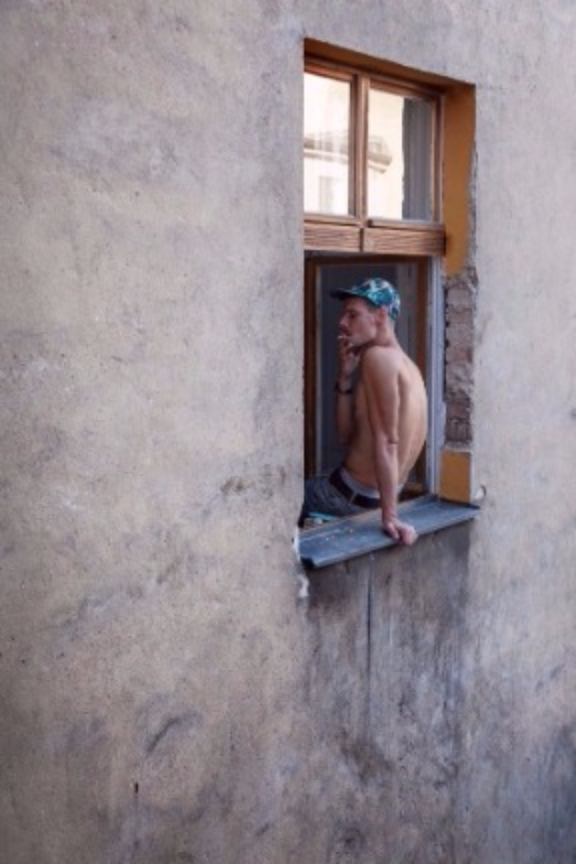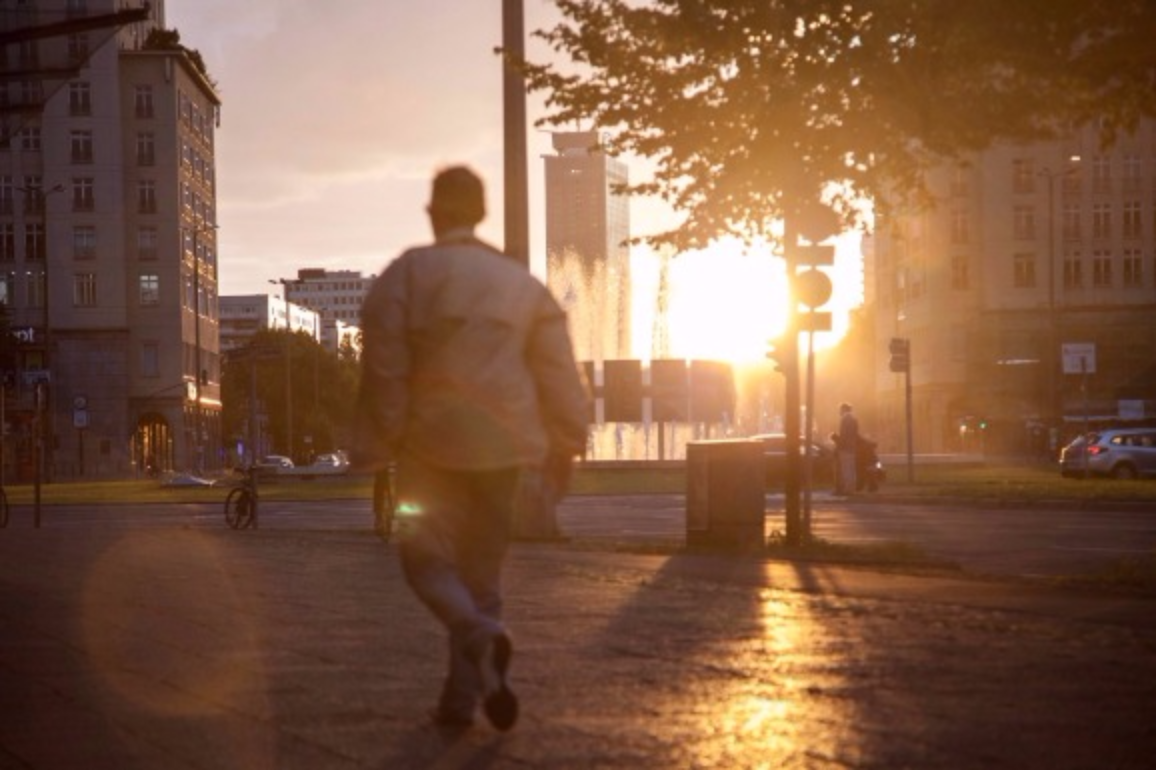Danke, Berlin
Text by Dan Saniski
Photography by Andy Egelhoff

After any exchange of extended intimacy, like cuddling, kissing, or more intimate pursuits, it’s customary in Berlin to hug and say “thank you.” This bit of gratitude and kindness informs the city’s queer techno culture enormously. At every party I’ve attended, people welcome you with open arms – as long as you’ve found your way to the secret dance enclaves, you’re welcomed into the tribe and feel the community, whether real or chemically induced. And these places are well hidden.
Walking near the canal in Neukölln, there is a gas station. At the far end of the gas station parking lot is a tall, metal gate. Past the gate, down a long path, the bass starts rumbling. Once through the bland exterior, spinning chandeliers hang from the open sky and poof — you’re in Beitola, a magical tree-lined dance party in the warm night. Deeper into Neukölln, at the traveling party Cocktail d’Amore, in an otherwise indistinct part of town, there is a driveway leading far back from the street. A little plywood shack stands at the end of the long walk, and inside is a wonderland straight out of an industrially inclined child’s imagination. Tree houses made out of 4x4s rise into the tree canopy and shake precariously as people climb up them. Muscular, shirtless men dance on the roof of a wrecked car. Long stretches of corrugated iron and flimsy fencing form an extensive maze of cozy, intimate corners full of discrete moments and “thank yous.” Underneath the tree houses are couches, chairs, or benches full of people cozying up. Since Cocktail d’Amore is on the canal, there are a series of little docks, logs, and chairs where hard-partiers sit to get some sun and take a break along the tranquil water. Graffiti on the canal’s barriers reads “freaks” in lavish, blue cursive font. The graffiti fits the scene perfectly.

The predominant vibe at all of these parties is that a mythical world awaits just beyond the roadside, just behind the gas station. Part of what makes it magical is the music – endlessly sub-genred techno beats enrapture the crowd, transporting them out of their heads. Well, that and the drugs. Since nightlife is so economically valuable to the city, among other reasons, drug enforcement is quite lax. The crowd is wildly diverse and willing to get into it. I got into long discussions about Foucault followed by campy shouting about RuPaul’s Drag Race, followed by trends in techno culture. There are service workers, artists, academics, black market beauties, and tech workers from the many startups popping up across the city. And in the span of an hour, I shared drinks with Americans, Israelis, Brazilians, French, and even a charming lad from Tasmania.
I sat down for lunch with Dr. Luis-Manuel Garcia, Assistant Professor of Ethnomusicology at the University of Groningen and Adjunct Researcher at the Max Planck Institute for Human Development, to work out what makes Berlin gay club culture unique. Garcia says that today’s queer music scene got much of its look and feel from fetish parties of the early 2000s. He says that in addition to the attire, they brought a culture with relaxed views towards sex and a general “go big or go home” attitude. These parties set much of the tone for drug use as well, since the idea plays heavily into BDSM practices which toy with control and submission. Of course, within party culture there is a sense of joyful pleasure in the submission to something else – some outside agent that takes over – whether it’s a drug, the music, or a person. There are many avenues for control and submission in both scenes.

In Garcia’s research, when people are asked why they party, all of them start with the music and go from there. The music is the real point. It’s why they come, why they stick around, and why they dance for 12 hours or more – the music moves the dancer. Really successful DJs do something to you that knocks you out of your normal habits. So naturally the established fetish scene intersected with the techno nerds enough to create a massive gay music scene that is quite sex-positive, fetish-inflected, drug- friendly, and musically-obsessed.
After the first such queer fetish-techno parties, like Snax, started, more followed. Just a few at first, and then many more over the last five years. People who weren’t into mainstream pop music remixes and drinking culture found they could do something about it. Since party space in Berlin is relatively inexpensive and people are comfortable dancing in warehouses and old factories, people can create a new party without having to invest significant amounts, lowering the bar to entry.
Aside from the locals and their needs, thousands of “techno tourists” fly to the city each week on cheap flights from across Europe and further afield to come party. As Dr. Garcia says, a subsection of these, the techno migrants, find the scene so inviting and compelling that when something goes south on them, their job or relationships, for example, they pick up and come to Berlin in search of music and camaraderie. They are powerfully drawn by the sounds, the people, and the radically open vibes. People talk about it like they used to talk about San Francisco in the 1970s. The Tales of the City types show up on holiday with a suitcase and just never leave, or at least not for a long time.


Why do people keep coming back to these parties? Dr. Garcia observes that club- bing offers an array of pleasures alongside a temporary release from certain kinds of responsibilities. He says, “In our increasingly neoliberal system, individual responsibility has become a dominant ideology, especially the individual as separate from the community. Clubs get you outside of that space of rationality and provide an interaction with some form of community, or at least perceived community. This community provides space for intimacy and experimentation of all sorts.” He goes on to say, “One of the major benefits of drug taking is that it ejects you from the realm of intentionality. Pushing oneself to one’s limits is a way of getting out of established cycles of behavior, and opening up to this serendipity – or disaster – is a gamble worth making.”
And disasters can and do come. Drugs are a centerpiece of the club culture here, and partygoers take a variety of substances broad enough to require a dictionary. New concoctions with names like “transformers” or random letter combinations like “ZB32” appear and vanish just as quickly, making it difficult to keep up with the ever-evolving supply. One of the most popular drugs here, GHB and/or GBL – both equally referred to as “G” – produces feelings of contentment, acquiescence, and is a strong aphrodisiac as well. The catch is that it slows how quickly the body processes alcohol, and taking too much causes a “G drop” where you literally fall over and are unresponsive for at least half an hour. Over the course of a long party, I witness this happen to a few people. Their friends drag the slack bodies and throw them in a chair, slap their faces about and shout until they start fighting back. As long as they don’t fall asleep, it’s assumed they’ll rouse. Though unfortunate, overdoses can happen on anything, alcohol included, but that’s not where the darkness lies. It’s what happens to some people afterwards that’s more than a little frightening.

Over the course of a full day at a party, I would see a person fall into one of the chairs, get pulled back from the brink by their friends, and then keep partying. Ten hours later, they were back at it, still chasing their high. And they return to do it all over again the following weekend. There is one guy – pleasant, but with haunted eyes – who overdoes it to the point where he devolves from open and cheerful to practically murderous, clutching his fists and attacking inanimate objects. Seeing this happen two weeks in a row – the second time resulting in him wildly and furiously swinging his backpack around – I asked people why he was allowed in. Everyone shrugged it off and said that he was broken, but better here than out there alone.
I talked with Jesus Martinez, founder of DJs Can’t Cook, about the dark side of partying. He says, “People can really lose themselves here. I mean, I lost myself a bit – wanting to go to Berghain all the time – because I didn’t have this before, and now I have it, whenever I want it. I always say that in Berlin you have three months after you arrive where you just completely fuck yourself up and get lost and then you backtrack from there. You did it, you know what it’s like, and then you start to organize yourself. Some people fall right back into it, some people don’t come out of it for months, a year, or end up leaving Berlin because they can’t handle it.”
Bad days and overindulging aside, the Berlin gays-with-beards set, here again with their razor cuts and DIY attitudes, like so many other places around the world, party like professionals. The crowd doesn’t value substances for the express purpose of getting radically altered in a hurry, but rather to create an internal symphony that evolves over the day or days. Guys take a bit of this and a bit of that, trying to ride out the party instead of destroying themselves immediately. It’s an endurance sport – many parties last 12 to 24 hours, so they really learn to pace themselves. As Garcia points out, when you go to a bar that closes at 2 a.m. or a club that closes at 4 a.m. you push yourself harder and faster, but when it could go for days, the game changes.
Here, drug-taking is as openly social as drinking at a bar, with one major exception: it all takes place in the toilets. In North America, and many other places around the world, people who get high do so with enormous discretion, sneaking off one or two at a time into a stall to take a hideously concealed sniff of whatever, a chorus of snorts rising over the hand-washing nearby. However, toilets in Berlin are comparatively gigantic and can comfortably fit six to 10 people. Dr. Garcia says that in Berlin there is a gentlemen’s agreement that as long as you go in the toilets and take your doses, and they can’t visually see you, they won’t remove you. If they see you though, they have to remove you.

Standing in line to use a toilet, each vacating stall looks like a clown car, with an impossibly huge number of people piling out. In the stalls, people are snuggled up against one another and quickly forget that the neighboring stalls can clearly hear what’s happening inside. Jesus says toilets are like the party’s living room, where people head for intimate chats, or just to get freaky. He goes on to say: “My favorites are the ones that don’t even have a toilet seat or a urinal: It’s just a room. And the toilet broke, and they’re just like ‘ah, fuck it. We’ll keep these 3 or 4 stalls, because they’re going to use them anyway.’”
After a long weekend of dancing, everyone creeps out into the sunlight, not entirely sure what day it is, and walk, bike, or cab home to crash, cuddle, or continue. Then Monday comes, like always. It’s easy to imagine that these clubs exist in a parallel universe, where the denizens vaporize as they stumble into the sun outside the doors of Berghain, but they all have lives.
For the artists and freelancers, it’s easy to recover when necessary. For the Monday- Friday crowd, things are a bit trickier. A friend of mine had a Monday meeting that he slept through accidently, but so did the guy he was meeting with. They spontaneously rescheduled for later in the day, both giggling out apologies for their tardiness. There are some companies, especially the ones in the music and entertainment industries, where nothing important is ever scheduled or due on Mondays. As the week rolls on, you run into your club friends out in the streets, planning out the next parties.
Having only spent a few weeks in Berlin, I quickly met enough people at parties that I would regularly have to stop and chat with new acquaintances I’d bump into while running to the store or getting lunch. Instead of feeling like the club is detached, or trapped in these tiny, otherworldly spaces, the parties and their regulars appear everywhere, every day.
There are, of course, lots of other gathering spaces aside from the parties. Berlin is surrounded by lakes and full of parks, many of which have gay, and often nude, sections off to the side. When the weather is especially nice, the gays flock to the beaches or the park’s gay corners, hanging out with friends in the endless summer days – a welcome reprieve from the claustrophobia of confined club spaces. Affable and cruisey, these beaches and parks are filled with many of the same people seen at night, and it’s often out here that parties are either made or destroyed, with people deciding what the next big thing is.
The endless possibility of parties makes it hard to keep motivated when you’d rather be dancing. People share ideas and come up with creative projects while out, but the number of distractions here is effectively infinite. Jesus has seen so many people get sucked into a lackadaisical attitude. He says that in Berlin the hardest thing to keep is your drive:
“You’re surrounded by people who have a lot great ideas but don’t always start them. And they talk a lot, but they don’t always follow through. Here, it’s just so easy to fall into the leisurely vibe, and to keep your mind on track you have to work hard to stay strong.”

With sufficient motivation though, it is possible. Marc Miroir, who has been running the monthly party called Members for the past two and a half years, knows a lot about this dedication and manages to maintain a reasonable work-party balance. To keep his motivation up and keep the party going Marc goes to the gym, runs a few times a week, and runs Paso Music, the label he’s owned and operated for the past ten years. Having lots of hobbies and vigorously exercising keeps him and many others going. It’s not uncommon for the professional party set to exercise as hard as they party, and it definitely keeps them going. I’ve noticed plenty of yoga mats in the corners of apartments.
With the huge volume of techno tourists and migrants coming, there is some navel- gazing about whether the party scene canhandle the influx and continuous growth. Jesus thinks it can. For him, the ideal ratio is 80% regulars to 20% new faces. When this balance tips too far towards tourists, the parties evolve. Their most obvious strategy is to move locations – all of these parties change venues every few years, if not faster. They’ll also change the music, shifting genres harder or softer — to drumcode, Chicago house, or disco to shift the crowds. The crowds themselves can also change a party. Beitola started as a night for gay techno Brazilians, but has gotten more generally queer. Party Colare, run by two charming Italians, started as a campy, one-off Italo-Disco night to celebrate their first year in Berlin, but quickly shifted away from its Italo source and is now a popular, frequent party. As Jesus says, “When it’s a gay party, it’s an everybody party. It means the target audience for the promotion might be gay, but we’re not trying to exclude anyone.”
After just five days in Berlin, I felt an overwhelming urge to cancel my flight home. My heart nearly broke as the disinterested ticket machine printed out my boarding pass. Each whir and click of the printer meant I was further from this city and its wonders.
Just three days back, I booked another trip, and returned to Berlin less than two weeks later. Maybe next time, it’ll be for good.